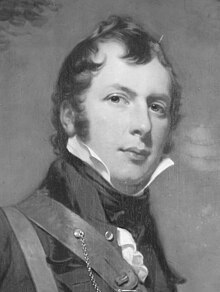Gerrit Schimmelpenninck
Gerrit, Count Schimmelpenninck | |
|---|---|
 | |
| Chairman of the Council of Ministers | |
| In office 25 March 1848 – 17 May 1848 | |
| Monarch | William II |
| Preceded by | Office established |
| Succeeded by | Jacob de Kempenaer |
| Personal details | |
| Born | Gerrit Schimmelpenninck 25 February 1794 Amsterdam, Netherlands |
| Died | 4 October 1863 (aged 69) Arnhem, Netherlands |
| Occupation |
|
Gerrit, Count Schimmelpenninck (25 February 1794 – 4 October 1863) was a Dutch businessman and politician, whose views ranged from liberal[specify] to conservative.[1] He was the son of Grand Pensionary Rutger Jan Schimmelpenninck and a member of the Dutch Reformed Church. He was also the first holder of the modern day post Prime Minister of the Netherlands, then known as the Chairman of the Council of Ministers.
After other functions, among which chief of the Nederlandsche Handelmaatschappij, he became head of secretary in Saint Petersburg and later in London.
The primary reason of William II to get him to the Netherlands and have him be appointed as Prime Minister of the Netherlands was to keep Thorbecke out of the Council of Ministers. In March 1848 he became Chairman of the Council of Ministers, holding the ministerial offices of Minister of Foreign Affairs and Minister of Finance. His proposal to design a Constitution following British model, which would imply that the Senate could not be dissolved by the King, was rejected by the other ministers. He tendered his resignation on 14 May 1848 and was succeeded by Jacob de Kempenaer.
Schimmelpenninck was granted the honorary title of Minister of State on 1 December 1836.[1]
Honours
[edit] Commander in the Order of the Netherlands Lion (1849)
Commander in the Order of the Netherlands Lion (1849) Grand Cross of the Order of the Oak Crown (1851)
Grand Cross of the Order of the Oak Crown (1851)
References
[edit]- ^ a b "G. (Gerrit) graaf Schimmelpenninck". www.parlement.com (in Dutch). Retrieved 18 February 2024.
- Blok, P.J.; Molhuysen, P.C. (1918). "Schimmelpenninck, Gerrit graaf". Nieuw Nederlandsch biografisch woordenboek. Deel 4. A.W. Sijthoff's Uitgeversmaatschappij. pp. 1223–1225.

